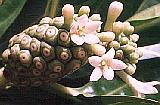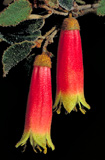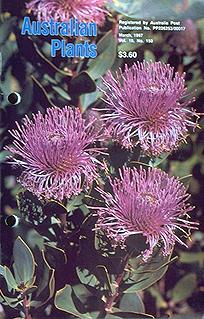|
[Front Page] [Features] [Departments] [Society Home] [Subscribe]

First Cuttings
Australian Plants Societies
Australian Plants online is brought to you by the 7 Societies that make up the Association of Societies for Growing Australian Plants (ASGAP).
Have you ever thought of joining one of the Societies? There is a Regional Society in every Australian state and also in the Australian Capital Territory. In addition, there are over 100 district groups established in centres throughout Australia.
Membership brings many benefits - regular district group and Regional newsletters, the colour journal "Australian Plants", access to free seed banks, regular meetings with expert speakers, bush walks, garden visits, advice from experienced growers, access to difficult to obtain plants and access to Study Groups.
Why not take a look at the Membership Page and see what we have to offer?

Net Watch
A few sites you might like to check out......
Native Orchids of North-eastern New South Wales
Greg Steenbeeke is responsible for this great piece of work. The site deals with all of the orchids to be found in northeastern NSW. Of the 174 species described, about 120 are imaged. All are given habitat and flower/plant appearance details, and a key is also provided.
The following is a brief extract from the site for the terrestrial orchid Corybas undulatus. Highly recommended!
 
This species is terrestrial, favouring littoral rainforest, dry rainforest, wet sclerophyll forests, dry sclerophyll forests, grassy sclerophyll forests and riparian (stream-side) areas.
- Flowering occurs during autumn and winter. Flowers are purple to red to white to greenish-grey, labellum white, edged in red, and are carried on a solitary, terminal stem.
- Foliage is basal, solitary, alternate, and the leaves are circular to broad-ovate, cordate.
- Similar species include C. hispidus, C. fimbriatus and C. incurvus.
- The species is considered significant. In the 1995 Rare or Threatened Australian Plants List it is rated as 3KC- (-NC).
Fixing Up the Country: Public Forum
Earthbeat is a programme on Radio National which is concerned with environmental issues. As part of Science Week in May, the programme featured a public forum at the Australian Museum in Sydney. The forum, "Fixing Up the Country: A Sustainable Vision for the Australian Landscape", brought together an eminent panel of speakers:
- Doug Shears; Executive Chairman of ICM Australia (ICM is Australia's largest privately owned agribusiness company).
- John Benson; Senior Ecologist at the Royal Botanic Gardens in Sydney.
- June Oscar; Deputy Director of the Kimberly Lands Council.
- Kevin Goss; Deputy Director of the Murray Darling Basin Commission.
- Cathy McGowan; President of Australian Women in Agriculture.
- Rick Farley; Managing Director of the Farley Consulting Group and one of the founders of the National Landcare Movement.
The forum was hosted by Alexandra de Blas and centred on solutions for the future including reconciliation with Aboriginal people. This site is simply the transcripts of the forum, in two parts:
Part 1
Part 2
It's all text (no graphics) but it makes for stimulating reading.
Now here's a useful little site. It's simply a list of common names for Australian trees. But there's hundreds of them!!....mostly native.
The format follows the following example:
| Common Name |
Genus |
Species |
REF |
| Fish KillerTree |
Barringtonia |
asiatica |
EA2 |
| Fish Poison Tree |
Barringtonia |
racemosa |
EA2 |
| Fishpoison-wood |
Barringtonia |
vitiflora |
NAT |
(The letters in the REF column are codes for the source publications).
The site is part of the larger "Woodlink" site which has been created by the Victorian Woodworkers' Association to make available to a wider audience information about Australian woodwork and woodworkers.
It includes examples of the work of Australian woodworkers, suppliers, information on health and safety and lots more.
Peter Dombrovskis was one of the most eminent landscape photographers working in Australia. His photographs of the Tasmania wilderness are represented in the collections of the National Gallery of Victoria, the Tasmanian Museum and Art Gallery, the Australian Heritage Commission and in numerous private collections. Sadly, on the 28th of March 1996 while photographing the Western Arthur Range in Tasmania's remote southwest, Peter Dombrovskis died from a massive heart attack.
This site displays examples of his beautiful work and offers posters of some of his photographs to be ordered.
Tahitian Noni Juice
To illustrate Lenore Lindsay's article on Bush Foods in this issue I needed to hunt around for suitable photographs. One of the plants mentioned by Lenore is Morinda citrifolia, known in Australia by several names including cheesefruit, koonjerung, tokoonja and great morinda.
However, I soon discovered that M.citrifolia is not just a native of Australia but occurs through tropical areas of Asia and Polynesia. As Lenore mentions in the article, the juice from the fruit is regarded as having a range of medicinal properties. In fact a small industry has buit up around the fruit which is being marketed as "Tahitian or Hawaiian Noni". There is a high demand for the juice as an alternative medicine for a host of illnesses.......athritis, diabetes, high blood pressure, muscle aches and pains, menstrual difficulties, headaches both mild and severe, heart disease, AIDS, cancers, gastric ulcers, sprains, mental depression, senility, poor digestion, atherosclerosis, blood vessel problems, drug addiction and more!
 |
The juice of cheesefruit Morinda citrifolia is claimed to be an effective natural remedy for a variety of illnesses. It is sold under the name "Tahitian noni juice".
Select the thumbnail image or highlighted name for a higher resolution image (33k). Photo: Ian Sutton
|
It all seems too good to be true.......and the cynic in me suggests that maybe it is.
Anyway, here's a couple of sites you might like to check out:
The interesting thing is that I could find no evidence of any Australian company cashing in on the market.

Common Name Woes
It's good to see that I'm not the only one frustrated by Australian Geographic magazine's editorial policy on plant names. Several readers wrote expressing similar annoyance.
Colin Cornford probably summed up the responses. Colin wrote.....
"I have written to Australian Geographic on two occasions to protest about the non-use of botanical names of Australian plants in articles. The replies I received were not very satisfactory and indicated that the question of whether or not to include scientific names in articles was settled in 1998. The outcome was that it was decided by the hierarchy of the journal to include scientific names alongside photographs dominated by species of Australian plants or animals but, in the interests of maintaining the easy-to-read style of the journal , it was decided to use only common names within the articles unless the plant or animal only had a scientific name.
I cannot see how the inclusion of a scientific name would detract from the readability of any of the articles. As I pointed out to the journal common names can vary from place to place and the same common name may be used in different localities to describe plants not related to each other. I used "myrtle" as an example - some Calytrix spp. are known as myrtles, some Melaleuca spp. are known as myrtles and some of the Backhousia spp. are also known as myrtles. Unfortunately , my complaint didn't seem to have any effect as scientific names are still not being given within the text of articles in the journal.
Perhaps ASGAP should make a more concerted effort to try to influence the journal to use scientific names and I imagine that groups involved with Australian animals would also like to see scientific names used more widely."
Lest anyone think that ASGAP is against the use of common names, I hasten to reassure you that's not the case. It's just that common names of Australian plants can be very misleading. Take "native fuchsia" as an example.....I've seen that name applied to Correa reflexa, Epacris impressa and Eremophila maculata! None of these are related to each other (except that they're all plants with tubular-type flowers) and it takes something of a vivid imagination to see much resemblance to the exotic fuchsia.
 |
 |
Native fuchsias???
Eremophila maculata, spotted emu bush (left),
Correa reflexa, common correa (right top)
Epacris impressa, common heath (right bottom).
Select a thumbnail image or highlighted name for a higher resolution image (29k, 27k and 39k).
|
 |
Anyway...the policy at Australian Plants online is to use the botanical name together with the common name when there is a generally accepted one available....which, regrettably, is not often! I may occasionally slip up but I don't mind if you tell me!

Australian Plants....in print!!!
"Australian Plants online" is a fairly recent publication of the Association of Societies for Growing Australian Plants but the Society has been involved in publishing for much longer....since 1959 to be exact, when the first issue of the journal "Australian Plants' was published.


"Australian Plants" is a 48 page, quarterly journal packed with information of practical interest to the average grower but also including reports on recent scientific research. The journal is liberally illustrated with colour photographs and drawings and has built up a high reputation since its first issue in 1959. It is held in many libraries both in Australia and overseas.
The journal regularly features up-to-date information on new species, new cultivars and hybrids, new propagation techniques and plant identification changes.
The "Australian Plants" journal is included with Society membership (either as a standard benefit or by means of an additional fee). It is also possible to subscribe to independently of Society membership. The cost is $18 annually ($AUS32 overseas), including postage. If you would like to subscribe, print out the Subscription Form and post or fax the appropriate fee to the address indicated on the form.
Here's a sample of some of the topics covered in recent issues,
Cassia and Senna in Australia
Australian Ferns - Growing them successfully
Smoke induced germination
Tea trees
The "Honeypot" Dryandras
Bernawarra Gardens - Tasmania
Plants for wet areas
Philotheca and Eriostemon - name changes
Lilly Pilly cultivars
Tropical legumes
Eucalyptus cinerea - lignotuber studies
Nutritional needs of Proteaceae
Labichea and Petalostylis
Xyris in Australia
Ferns in a garden
Yellow Waratah...Telopea truncata form
"Pines" of Tasmania
Tasmanian plants in horticulture in Britain
Eucalypts of Tasmania
Cut flower production trials
Emu Bush - Growing Eremophila
Kangaroo Paws - for colour
Creating a native garden...For beginners
Native honeysuckle; The genus Lambertia
Fertilizing for grevilleas
Creating homes for birds and mammals
Mistletoe; their natural biological control
|
Sun Orchids - Thelymitra
Eucalyptus Foliage - Cut stems and postharvest
Vegetation of Macquarie Island
Grevillea - care and maintenance
Proteaceae of the rainforest
Richmond Birdwing butterfly
Terrestrial orchids of Royal National Park
Bladderworts - carnivorous plants
New Banksia releases
Edible wattle seeds - southern Australia
An introduction to legumes of Australia
Orchids as garden features
Native lowland grasslands of Tasmania
Orities - Tasmanian endemics
Gardening in clay
The daisy family
The tea tree oil industry
Riceflower - an everlasting daisy as a cut flower
Corkwood as a source of medicine
Outback Gardening - Achieving water efficiency
Pioneering Quandong as a fruit
Commercial cropping in the dry Interior
Bush food plantations
Rainforest plants - horticulture and bush tucker
Native fruits - Aboriginal food
About plant roots
NSW Christmas Bush: Cut flower industry
|
[Back to Top]
Good growing
Brian Walters

[Front Page] [Features] [Departments] [Society Home] [Subscribe]
Australian Plants online - June 2000
Association of Societies for Growing Australian Plants
|